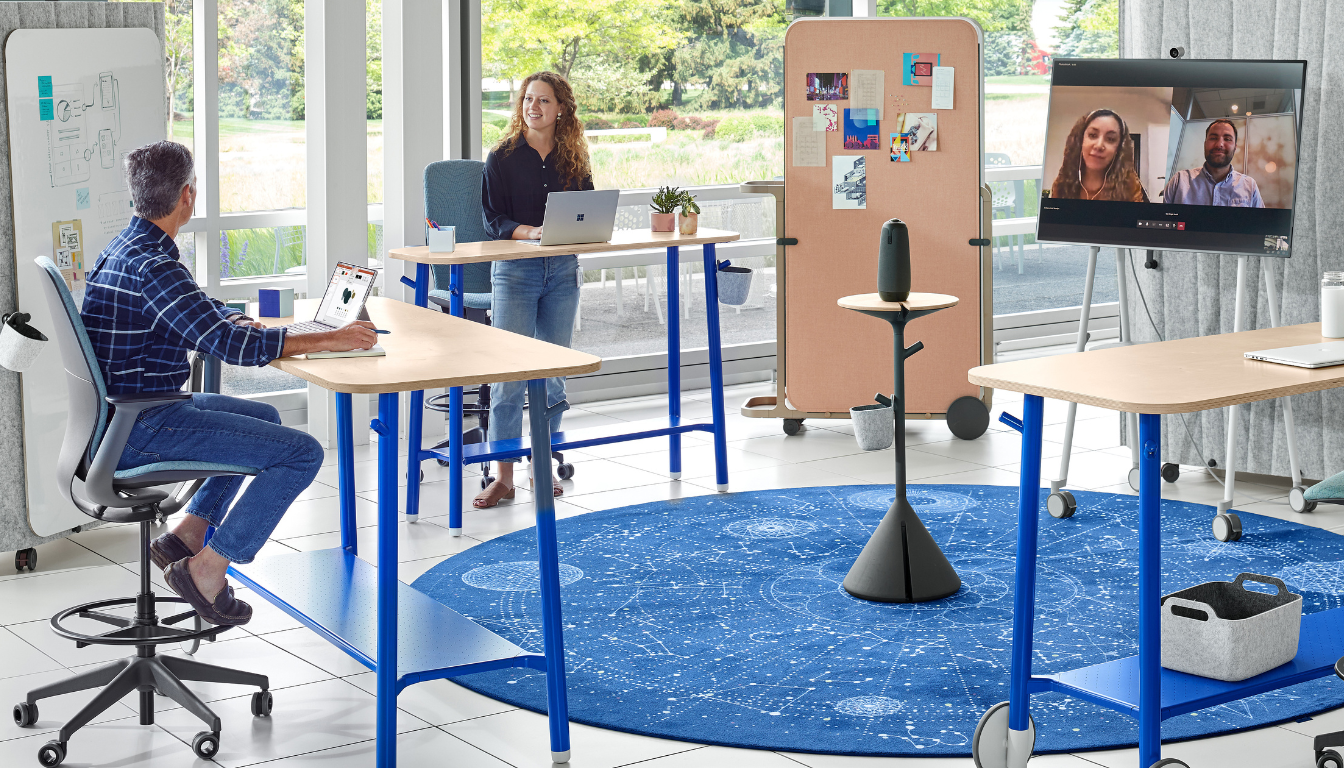Top Hybrid Workplace Best Practices for a Productive 2025

Seeking hybrid workplace best practices? Our guide provides practical advice on balancing remote and on-site work, improving team communication, and boosting overall productivity. Discover the key strategies your organization needs to thrive in a hybrid work environment.
Key Takeaways
- Over 70% of U.S. companies now adopt hybrid work models, yielding improved work-life balance and productivity for employees.
- Hybrid workplaces enhance employee retention and satisfaction, with a flexible model attracting a wider talent pool and saving costs for employers.
- Key best practices for effective hybrid work include clear communication, fostering a strong company culture, and implementing flexible work policies.
Understanding the Hybrid Workplace

The hybrid workplace is a flexible approach combining office and home work, allowing employees to alternate between working onsite and work remotely. This model, which blends on-site collaboration with remote flexibility, has become the preferred arrangement for many organizations. Over 70% of U.S. companies now utilize some form of hybrid work, reflecting a substantial shift in work arrangements post-pandemic.
The pandemic accelerated the movement towards hybrid work arrangements, highlighting the need for flexibility in work environments. Leaders have successfully navigated to find a solid middle ground for hybrid work, balancing business needs with employee preferences. Predictions indicate that nine out of ten organizations will combine remote and onsite working environments in the future.
Employees who work in hybrid settings report better work-life balance and increased productivity, making this model highly appealing. The hybrid work model has evolved significantly over time, becoming a flexible and modern working method that organizations are pursuing. Surveying diverse employees and leaders is crucial for understanding workplace preferences and improving hybrid work schedules experiences. A hybrid work schedule can further enhance these benefits.
Advantages of Hybrid Work Models

The hybrid workplace offers numerous advantages that contribute to employee engagement and retention. Offering flexibility helps employees achieve a better work-life balance, which leads to higher job satisfaction and overall well-being. This model also allows for greater autonomy and flexibility in managing work schedules, which can result in improved employee productivity.
Hybrid work models are not only beneficial for individual employees but also for employers in a hybrid workforce, promoting a culture of hybrid working. The hybrid work model offers advantages that enhance productivity and employee satisfaction, as highlighted in the Harvard Business Review.
Companies adopting hybrid work can:
- Save approximately $11,000 per year for each employee in cost savings
- Reduce workspace requirements by 40%
- Open up access to a wider and more diverse talent pool by eliminating geographical limitations
Job postings featuring remote work options attract 2.8 times more candidates, making it easier for organizations to find skilled professionals regardless of their fully remote location, thus creating a wider talent pool.
Furthermore, 81% of employees are more likely to remain with a company that offers flexibility in their work model. This flexibility not only enhances employee satisfaction but also supports companies in accessing skilled professionals regardless of their location. As a result, rapidly growing companies are increasingly utilizing hybrid work models, underscoring the attractive nature of this work arrangement.
Common Challenges in Hybrid Work Environments
While the hybrid workplace offers numerous benefits, it also presents several challenges that organizations must address. Communication is essential in hybrid teams to ensure all employees receive timely information and context for their work. However, hybrid work setups can lead to inconsistent communication, affecting team cohesion.
Ensuring that all team members feel included, regardless of their work location, is a major issue in hybrid settings. Organizational culture may weaken if not actively nurtured across both remote and in-person teams. Managing team dynamics is often complicated by the diverse experiences of remote and in-office workers and their personal lives.
Leadership must adapt to manage a workforce that toggles between remote and on-site. This includes finding ways to maintain a strong company culture, addressing the unique needs of remote employees, and ensuring that communication remains clear and consistent. By acknowledging and addressing these challenges, organizations can create a more cohesive and productive hybrid work environment.
Best Practices for Effective Hybrid Workplaces

Implementing effective hybrid workplace practices is crucial for fostering a productive and inclusive work environment. Prioritizing clear communication, fostering a strong company culture, and implementing flexible workplace culture policies are essential for success.
Let’s explore these best practices in detail.
Establish Clear Communication Channels
Clear communication is the backbone of any successful hybrid workplace. Mixed communication tools like video conferencing, instant messaging, and email are essential for effective communication. Cloud-based platforms like Microsoft Teams and Zoom significantly enhance communication and collaboration tools. These platforms enable instant messaging and video calls, fostering a culture of open dialogue among remote and in-office staff.
Integrating various communication methods enhances connectivity and keeps teams engaged. Clear communication channels are vital for maintaining synchronization among team members across different locations. This ensures that everyone is on the same page and can collaborate effectively, regardless of their work location.
Foster Strong Company Culture
A strong company culture is vital for the success of a hybrid workplace. Regularly scheduled team meetings, whether virtual or in-person, strengthen relationships and reinforce company culture. Transparency and shared information help maintain a strong company culture in a hybrid environment.
Organizing virtual team-building activities and regular check-ins helps reduce isolation in remote workers. Team building in a hybrid workplace ensures smooth functioning and strengthens team member relationships. Practices that promote inclusivity can ignite a sense of belonging among team members.
Valuing diverse perspectives and creating experiences around core values supports company culture and enhances employee engagement.
Implement Flexible Work Policies
Flexible work policies are crucial for the success of a hybrid workplace. There are several models of flexible work arrangements in hybrid workplaces, including Office-First, Remote-First, Split-Schedule, Team-Designated, and Fully Flexible. The Fully Flexible Hybrid model emphasizes employee autonomy and choice in determining their work arrangements.
Clearly communicating the hybrid work policy is crucial for guiding employee behavior and expectations. Empowering teams to design their own hybrid work practices leads to better alignment with employees’ needs and preferences. About 40% of hybrid workers can set their own office schedule, which fosters a sense of autonomy.
Clear expectations and boundaries are essential for defining work expectations in a hybrid model to ensure productivity.
Technology Solutions for Hybrid Work

Investing in the right technology is essential for a successful hybrid workplace. Hybrid work models require tools that facilitate collaboration and communication for both remote and onsite teams. Integrating various tech tools promotes a seamless experience and prevents communication issues within hybrid teams.
Robust workplace management software is essential for optimizing space utilization and enhancing employee experience in hybrid environments. Office space management software allows employees to book on-demand desks, parking, and meeting rooms. Data-driven tools can help in understanding traffic patterns and space allocation in hybrid workplaces. Advanced analytics tools provide insights into office utilization, enabling more effective space management.
In-person meetings can enhance communication and collaboration, with face-to-face interactions enabling better interpretation of body language and immediate problem-solving. Organizations should categorize meetings to ascertain whether they warrant in-person attendance, particularly for discussions requiring deep collaboration or relationship building. Investing in high-quality audio-visual technology is crucial for hybrid meetings to ensure equal engagement for both in-person and remote participants.
Performance Management in Hybrid Teams
Performance management in hybrid teams requires a balanced approach that considers both outcomes and employee engagement. In hybrid teams, visibility into employees’ work can be limited, which may affect managers’ confidence in assessing performance. Recognizing both activities and outcomes is important for a holistic view of employee performance in hybrid settings, especially when utilizing a performance management system.
Performance metrics in a hybrid work model should focus on results rather than micromanagement. Establishing clear goals and performance metrics is crucial for managing performance in hybrid teams. Employees’ performance should be assessed based on output rather than hours worked.
Regular performance feedback in a hybrid setting is critical to maintaining employee motivation and clarity on expectations. A practice that helps in discussing progress in a hybrid team includes regular check-ins. A balanced approach to performance metrics should combine qualitative and quantitative measures.
Enhancing Employee Well-Being
Enhancing employee well-being is a cornerstone of a successful hybrid workplace. Employees gain greater autonomy and flexibility in managing their work schedules, leading to improved healthy work life balance. Promoting work-life balance is a primary method to enhance employee well-being in a hybrid workplace.
Investing in ergonomic furniture and quality hardware enhances remote work setups for employees, improving their well-being. Counseling services and stress management programs are available to employees. These resources can significantly support mental well-being. Encouraging clear boundaries between work hours and personal time can help employees establish better work-life balance.
Implementing strategies such as virtual team-building activities and regular check-ins is important. Additionally, recognition programs can help ensure employees feel connected. Providing opportunities for professional development can strengthen trust and engagement in a hybrid environment. Actively addressing the challenges of remote work helps create a healthier and more supportive work environment.
Building Trust and Engagement
Building trust and engagement in a hybrid workplace is essential for a cohesive and productive team. Trust in a hybrid team relies on a clear definition of what trust means within the organization. Modeling trustworthy behavior, such as punctuality and openness, fosters a culture of trust among team members.
Open and frequent communication is essential in hybrid setups to prevent miscommunication and enhance trust. Consistent feedback helps build trust and collaboration among team members, regardless of their physical location. Employees tend to report higher morale and a stronger sense of belonging after participating in in-person meetings, fostering a more cohesive work environment.
Continuous Feedback Mechanisms
Continuous feedback mechanisms are crucial for the success of a hybrid workplace. Listening to employees, such as through pulse surveys, is essential for understanding their needs and enhancing trust. Employee feedback is vital for co-designing hybrid work approaches and ensuring successful adoption.
Methods for gathering employee feedback in a hybrid workplace include always-on Slack channels and quarterly feedback surveys. Organizations should address and resolve the concerns raised by feedback collected from employees. By implementing continuous feedback mechanisms, organizations can create a more responsive and adaptable hybrid work environment.
Planning In-Person Gatherings
Planning in-person gatherings is essential for fostering stronger relationships among team members in a hybrid setting. In-person gatherings build relationships among team members, enhancing collaboration in a hybrid setting. Key elements of engaging events include interactive activities, opportunities for networking, and fostering a creative environment.
Utilizing services like Offsite helps organizations plan logistics and activities that align with both team goals and corporate culture. Planning meaningful in-person gatherings complements virtual collaboration and creates a sense of unity across locations.
Preparing for the Future of Hybrid Work

As we look to the future, exciting trends and predictions are emerging that will shape the hybrid workplace. Technologies like virtual reality (VR) and augmented reality (AR) are expected to enhance remote collaboration. A 37% reduction in office traffic is forecasted as long-term remote work flexibility becomes more common.
Since mid-2022, most employees who are capable of working remotely have established their long-term work locations. They have settled into these projected arrangements. Fortune 500 CHROs indicate they have no plans to decrease remote work flexibility.
A key starting point for developing a long-term hybrid strategy is to assess how to embrace advantages and address challenges of hybrid work. Staying ahead of these trends helps create a future-ready hybrid work environment.
Summary
In summary, the hybrid workplace offers a blend of flexibility and productivity that is appealing to both employees and employers. By understanding the advantages and challenges of hybrid work, organizations can implement best practices to create a successful hybrid work environment. Prioritizing clear communication, fostering a strong company culture, and implementing flexible work policies are essential for maintaining employee engagement and well-being.
As we move forward, embracing technology and continuous feedback mechanisms will be crucial for the success of hybrid work models. Planning in-person gatherings and preparing for future trends will help organizations stay ahead in the ever-evolving work landscape. The future of work is hybrid, and by adopting these best practices, organizations can create a thriving and dynamic work environment.
FAQs
- What is a hybrid workplace?
A hybrid workplace combines in-office and remote work, providing employees with the flexibility to alternate between both environments. This model enhances work-life balance while maintaining productivity and collaboration.
- What are the advantages of a hybrid work model?
The hybrid work model offers improved work-life balance, enhanced productivity, significant cost savings, and access to a diverse talent pool. This approach can greatly benefit both employees and employers.
- What are common challenges in hybrid work environments?
Hybrid work environments often face challenges such as communication difficulties, ensuring inclusion, preserving organizational culture, and managing team dynamics. Addressing these issues is essential for creating a cohesive and productive workspace.
- What are some best practices for effective hybrid workplaces?
To ensure an effective hybrid workplace, prioritize clear communication channels, nurture a strong company culture, and adopt flexible work policies. These practices facilitate collaboration and employee satisfaction.
You may also like
Unique spaces for your next offsite
Find distinctive venues for your upcoming corporate retreat.
Stay Updated with Our Insights
Get exclusive content and valuable updates directly to you.







